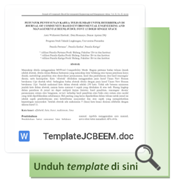Carbon Absorbing Vegetation and Enhancement of Ecosystem Benefits on Residential Environment
DOI:
https://doi.org/10.23969/jcbeem.v6i1.5114Keywords:
carbon emission, greenhouse gases, green open space, urban vegetationAbstract
With the increase in population, mainly in urban sprawls, the available vegetation decreases due to land conversion into the residential area. At the same time, the rise in population is proportional to the increase in air pollution, which is characterized by the Greenhouse Gases (GHG) problems. However, naturally, vegetation can absorb greenhouse gas emissions as a component in the photosynthesis process. Increasing space for housing is balanced with spatial regulations for the use of built-up land so that some of the carbon emissions from daily activities are reduced. Based on the research, there is still a difference between carbon absorption and carbon emissions; therefore, increasing the amount of vegetation as a Green Open Space (GOS) needs to be maximized based on the number and type of plants. The air pollution problem is attempted to be done naturally so that the ecosystem will naturally reduce the existing pollutants. The Community Service (CS) stages starting from land preparation, seed preparation, pathway construction, monitoring plantation, can be a solution to answer the problems of city dwellers on a housing scale. The overall implementation of the community services has gone well, such as constructing access pathways, planting trees and flower plants, and using land for public housing facilities into parks. The environment will be safer from wild and dangerous animals to create a better environment.
Downloads
References
Ahmad, F., Arifin, H. S., Dahlan, E. N., Effendy, S., & Kurniawan, R. (2012). Analisis Hubungan Luas RTH dan Perubahan Suhu di Kota Palu. Jurnal Hutan Tropis, 13(2), 173–180.
Badan Pusat Statistik. (2020). Kota Pontianak Dalam Angka. In Badan Pusat Statistik Kota Pontianak.
Badan Standarisasi Nasional. (2004). SNI Nomor 03 – 1733 – 2004 Tentang Tata Cara Perencanaan Lingkungan Perumahan di Perkotaan. 2004, 1–58. http://johannes.lecture.ub.ac.id/files/2012/10/Tata-Cara-Perencanaan-Lingkungan-Perumahan-di-Perkotaan-_-SNI-03-1733-2004.pdf
Hayati, S., Effendi, J., & Pasangka, B. (2016). Analisis Kebutuhan Ruang Terbuka Hijau (Rth) Privat Di Kota Kupang (Studi Kasus Di Perumahan Nasional Nefonaek Dan Btn Kolhua). Jurnal Keteknikan Pertanian, 4(1), 105316. https://doi.org/10.19028/jtep.04.1.
Jo, H. K., & McPherson, E. G. (2001). Indirect carbon reduction by residential vegetation and planting strategies in Chicago, USA. Journal of Environmental Management, 61(2), 165–177. https://doi.org/10.1006/jema.2000.0393
Kementerian Lingkungan Hidup. (2012). Pedoman Penyelenggaraan Inventarisasi Gas Rumah Kaca Nasional. In Pusat Data dan Teknologi Informasi Energi dan Mine (p. Pus. Data dan Teknol. Inf. Energi dan Mine).
Mimura, N. (2013). Sea-level rise caused by climate change and its implications for society. Proceedings of the Japan Academy Series B: Physical and Biological Sciences, 89(7), 281–301. https://doi.org/10.2183/pjab.89.281
Penataan Ruang Terbuka Hijau Kawasan Perkotaan, 1 (2007).
Purwatik, S., Sasmito, B., & ah, H. (2014). Analisis Ketersediaan Ruang Terbuka Hijau (Rth) Berdasarkan Kebutuhan Oksigen (Studi Kasus : Kota Salatiga). Jurnal Geodesi Undip, 3(3), 124–135.
Qiu, Z., Feng, Z., Song, Y., Li, M., & Zhang, P. (2020). Carbon sequestration potential of forest vegetation in China from 2003 to 2050: Predicting forest vegetation growth based on climate and the environment. Journal of Cleaner Production, 252. https://doi.org/10.1016/j.jclepro.2019.119715
Sunarti, Sunaryo, F. K., Prasetyo, B. E., Kurniadi, C. B., Setiadi, I., Rabbani, Q., Fajarwati, P. A., & Hernawati, S. (2020). Inventarisasi Emisi GRK Bidang Energi. Inventarisasi Emisi Gas Rumah Kaca Sektor Energi Tahun 2020, v. https://www.esdm.go.id/assets/media/content/content-inventarisasi-emisi-gas-rumah-kaca-sektor-energi-tahun-2020.pdf
Velayatzadeh, M., & Davazdah Emami, S. (2019). Investigating the effect of vegetation on the absorption of carbon dioxide (case study: Yadavaran oil field, Iran). Journal of Air Pollution and Health, 4(Summer), 147–154. https://doi.org/10.18502/japh.v4i3.1544














